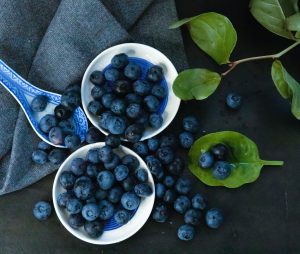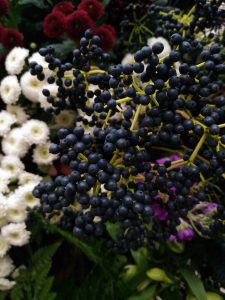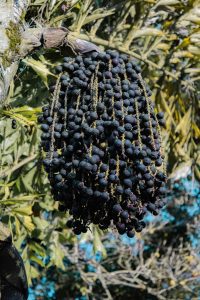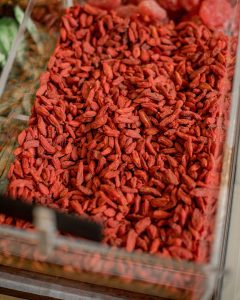
What Is a Quince?
A quince is a fruit belonging to the Rosaceae family and the Cydonia oblonga species. Native to Southwest Asia, this deciduous tree produces the quince fruit, which resembles a large, yellow pear. Known for its distinct aroma and tough, golden-yellow skin, the quince has a tart flavor when raw. However, when cooked or processed, it transforms into a sweet and fragrant delicacy.
Quinces are often utilized in culinary applications, especially in preserves, jams, jellies, and desserts. Due to their high pectin content, quinces are valued for their ability to naturally thicken and enhance the texture of jams and jellies. They also add a unique flavor to various dishes, such as poached quince, quince paste, and quince tarts. Despite being less commonly consumed in its raw form, the quince’s culinary versatility and aromatic qualities make it a cherished ingredient in different cuisines worldwide.
Why Do We Eat Quinces?
Quinces are consumed for several reasons, ranging from their unique flavor and aromatic qualities to their culinary versatility and potential health benefits. Here are some reasons why people eat quinces:
- Culinary Uses:
- Quinces are prized for their culinary versatility. They are used in a variety of dishes, including jams, jellies, preserves, compotes, tarts, and desserts, due to their ability to impart a sweet and aromatic flavor.
- Unique Flavor Profile:
- When cooked, quinces transform from their naturally tart state to a sweet and fragrant delicacy. The unique flavor, which is a combination of floral, citrus, and apple notes, makes them appealing in different culinary creations.
- Preserves and Jams:
- Quinces are high in natural pectin, a substance that contributes to the thickening of jams, jellies, and preserves. Their use in these products enhances texture and flavor.
- Traditional and Cultural Significance:
- Quinces have historical and cultural significance in various regions. They are used in traditional recipes and cultural dishes, contributing to the culinary heritage of certain communities.
- Aromatic Qualities:
- The aromatic nature of quinces adds a pleasant fragrance to dishes, making them appealing not just for taste but also for their sensory qualities.
- Nutritional Content:
- While not as commonly consumed for their nutritional content compared to some other fruits, quinces do provide vitamins, minerals, and dietary fiber, contributing to a well-balanced diet.
- Gourmet Cuisine:
- Quinces are often used in gourmet cuisine to add a sophisticated and unique touch to dishes. Their inclusion in upscale recipes showcases their potential for culinary innovation.
Overall, the consumption of quinces is driven by their distinctive flavor, culinary adaptability, and cultural significance, making them a sought-after ingredient in various culinary traditions around the world.
When Do We Eat Quinces?
Quinces are typically eaten when they are in season, which varies depending on the region and climate. In general, the quince season is in the late fall to early winter. The specific timing can differ based on the variety of quince and local growing conditions.
Here are some common times and occasions when people might eat quinces:
- Late Fall to Early Winter:
- This is the primary season for fresh quinces. During this time, they are harvested and available for consumption.
- Holiday Season:
- Quinces are often associated with the holiday season, and their use in festive dishes, preserves, and desserts makes them a popular choice for Thanksgiving and Christmas.
- Culinary Events and Celebrations:
- Quinces are featured in various culinary events and celebrations, showcasing their versatility in both sweet and savory dishes.
- Preserving Season:
- Due to their high pectin content, quinces are often used for making jams, jellies, and preserves. This preserving process allows people to enjoy the flavor of quinces beyond their fresh season.
- Special Occasions:
- Quinces may be incorporated into special occasion dishes, such as wedding cakes, tarts, and other celebratory desserts, adding a unique and sophisticated touch.
While fresh quinces may have a limited availability, preserved quince products, such as jams and jellies, can be enjoyed year-round. The specific timing of when people eat quinces can vary based on culinary traditions, local harvest seasons, and personal preferences.
Ingredients of Quinces
Quinces, like many fruits, don’t require additional ingredients as they are typically consumed fresh or used in various culinary preparations. However, when incorporating quinces into recipes, the ingredients may vary depending on the dish. Here are some common ingredients used in quince-based recipes:
- Quinces:
- The main ingredient, quinces, can be used fresh, peeled, cored, and sliced or diced, depending on the recipe.
- Sugar:
- Quinces are naturally tart, so sugar is often added to sweeten dishes like quince preserves, jams, and desserts.
- Water:
- When making quince preserves or compotes, water may be added to create a syrup or liquid base.
- Lemon Juice:
- Lemon juice is sometimes used to enhance the flavor of quince dishes and prevent browning. It also adds a citrusy note.
- Spices:
- Cinnamon, cloves, or other warm spices are often added to quince recipes, such as poached quinces or quince compote, to enhance the flavor.
- Vanilla:
- Vanilla extract or vanilla bean can be used to add a sweet and aromatic flavor to quince-based desserts.
- Pectin:
- In recipes like quince jam or jelly, additional pectin may be used to help the mixture set and achieve the desired consistency.
- Honey:
- Some recipes may use honey as a natural sweetener, especially in healthier or alternative preparations.
- Wine or Liqueur:
- Quinces can be poached or cooked in wine or liqueur to impart additional flavor and complexity.
Remember that the specific ingredients will depend on the quince recipe you’re following, whether it’s for preserves, desserts, sauces, or other culinary creations. The natural sweetness and unique flavor of quinces make them a versatile ingredient in both sweet and savory dishes.
Types of Quinces
Quinces do not have as much variety in terms of different types or cultivars as some other fruits, and there is a primary species commonly used for culinary purposes, which is Cydonia oblonga. However, there can be variations in the types of quinces based on regional differences and specific cultivars. Here are a few examples:
- Champion:
- This is a popular cultivar known for its large and fragrant fruit. It is often used for making quince preserves and jams.
- Pineapple Quince:
- Named for its pineapple-like fragrance, this cultivar produces aromatic and flavorful quinces. It is commonly used for cooking and baking.
- Aromatnaya:
- This Russian cultivar is recognized for its aromatic and sweet fruit. It is often consumed fresh or used in culinary applications.
- Smyrna Quince:
- This type of quince is known for its pear-like shape and is cultivated in various regions. It has a sweet and fragrant flavor.
- Portugal Quince:
- This cultivar is grown in Portugal and is valued for its large, aromatic, and flavorful fruit. It is often used for making quince paste or jelly.
It’s important to note that quince varieties may have different characteristics, including size, flavor, and fragrance. The availability of specific cultivars can also vary by region. When selecting quinces, consider the intended use, as some varieties may be more suitable for fresh consumption, while others are preferred for cooking, baking, or preserving.
Signs of Ripe, Signs of Raw and Signs of Rotten Quinces
Identifying the ripeness, rawness, or potential spoilage of quinces involves assessing various visual and sensory cues. Here are signs to help you determine the condition of quinces:
Signs of Ripe Quinces:
- Color:
- Ripe quinces typically have a golden-yellow color. The shade may vary, but they should have an overall yellow hue.
- Fragrance:
- Ripe quinces emit a sweet and floral aroma. The fragrance becomes more pronounced as they ripen.
- Texture:
- When gently pressed, ripe quinces yield slightly to pressure. The flesh should feel firm yet give a little.
Signs of Raw (Unripe) Quinces:
- Color:
- Unripe quinces may have a more greenish or pale yellow color. The absence of a golden hue indicates that they are not fully ripe.
- Fragrance:
- Unripe quinces typically lack the sweet and strong fragrance associated with ripeness.
- Texture:
- Unripe quinces feel firm and hard when pressed. They do not yield to pressure as much as ripe ones.
Signs of Rotten Quinces:
- Mold:
- Check for any visible signs of mold on the surface of the quince. Mold is a clear indicator of spoilage.
- Odor:
- Rotten quinces emit an unpleasant and off-putting odor. If the fruit smells sour or foul, it may be a sign of decay.
- Soft Spots:
- Gently press the quince. If there are soft, mushy, or discolored areas, the fruit may be rotting.
- Discoloration:
- Look for significant browning, dark spots, or changes in color on the skin. Discoloration can be a sign of deterioration.
When selecting quinces, aim for a balance between color, fragrance, and texture to ensure they are ripe and ready for consumption. Avoid quinces with signs of mold, off odors, or significant softening, as these may indicate spoilage.
Summary
Quinces, belonging to the species Cydonia oblonga, are versatile fruits prized for their culinary applications and distinct aroma. Recognized by their golden-yellow hue when ripe, ripe quinces offer a sweet and floral fragrance, yielding slightly to gentle pressure. Unripe quinces present a greenish or pale color, lack a strong aroma, and feel firm when pressed. The culinary appeal of quinces lies in their ability to transform from tartness to sweetness when cooked, making them ideal for preserves, jams, and desserts.
Varieties like Champion, Pineapple Quince, and Aromatnaya each contribute unique flavors and characteristics to quince-based creations. The fruit is often celebrated during its late fall to early winter season and holds cultural significance, particularly during festive occasions.
Consumers choose quinces for their culinary versatility, contributing to preserves, desserts, and gourmet dishes. These fruits, high in natural pectin, are valued for thickening jams and jellies. Despite a limited window for fresh consumption, quinces endure through preserved products, extending their enjoyment beyond the harvest season. Whether in holiday desserts, aromatic jams, or savory dishes, quinces maintain their relevance as a distinctive and fragrant addition to diverse culinary traditions.






